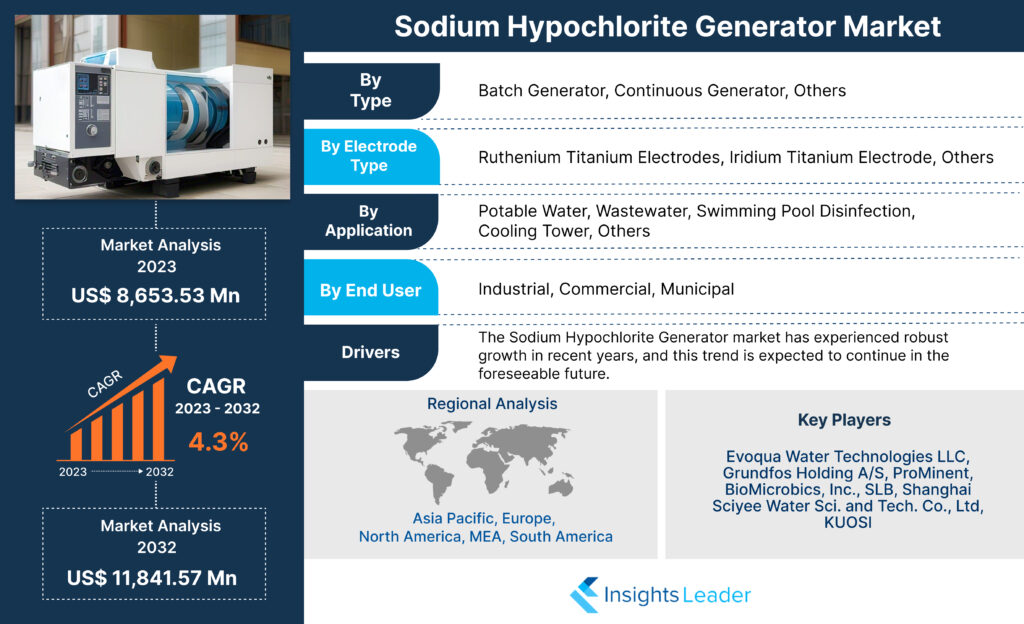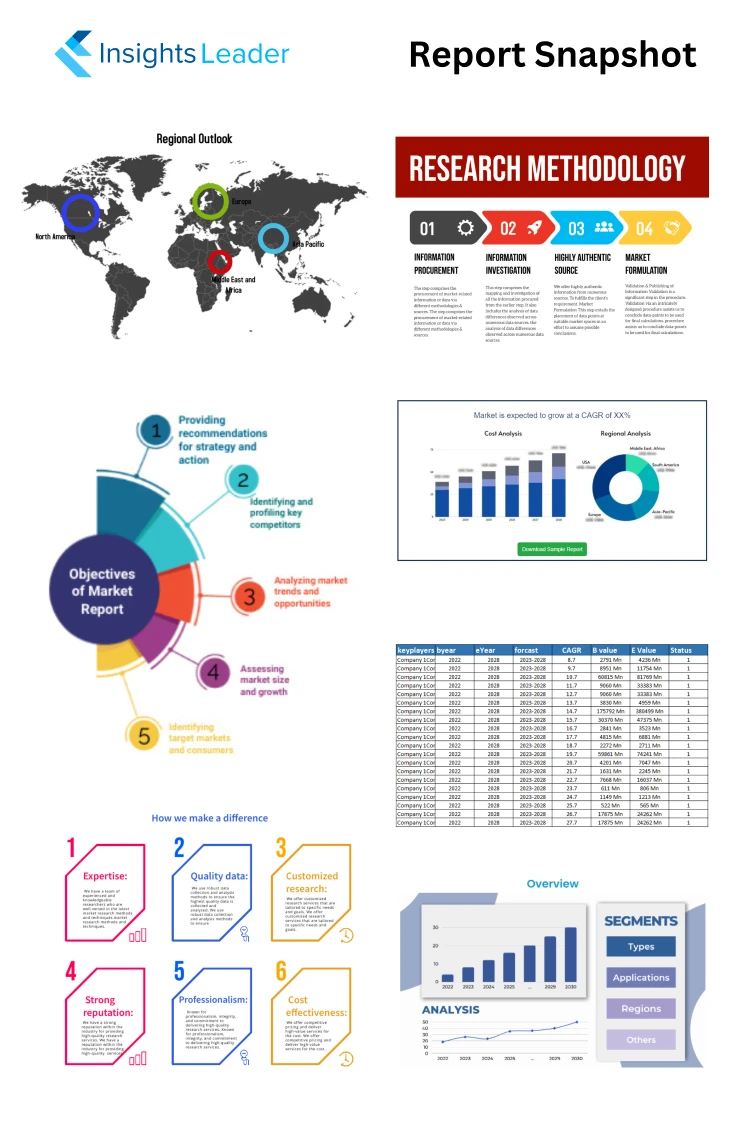Sodium Hypochlorite Generator Market Size 2023 to 2032
Sodium hypochlorite generator works on the principle of electro-chlorination that utilizes water, salt, and electricity to produce sodium hypochlorite. In sodium hypochlorite generators, a brine solution initially flows through an electrolyzed cell in which direct current is passed, in turn leading to electrolysis. The electrolysis process produces sodium hypochlorite instantaneously. The powerful oxidation and disinfection properties of sodium hypochlorite and its ability to prevent the growth of algae and microbes are increasing its application in water treatment in industrial, commercial, and municipal sectors. Factors including the rising pace of industrialization, increasing need for clean water, rising development of wastewater treatment plants, and the growing demand for efficient water treatment solutions are among the key factors driving the adoption of sodium hypochlorite generators. Additionally, factors such as the rising popularity of recreational centers with swimming pools, proliferation of commercial or public pools, and growing need for clean pool water are significant factors driving the application of sodium hypochlorite generators.
Report ID : IL_891 | Report Language's : En/Jp/Fr/De | Publisher : IL |
Format : 



Sodium Hypochlorite Generator Market Report Overview:
Sodium hypochlorite generator works on the principle of electro-chlorination that utilizes water, salt, and electricity to produce sodium hypochlorite. In sodium hypochlorite generators, a brine solution initially flows through an electrolyzed cell in which direct current is passed, in turn leading to electrolysis. The electrolysis process produces sodium hypochlorite instantaneously. The powerful oxidation and disinfection properties of sodium hypochlorite and its ability to prevent the growth of algae and microbes are increasing its application in water treatment in industrial, commercial, and municipal sectors. Factors including the rising pace of industrialization, increasing need for clean water, rising development of wastewater treatment plants, and the growing demand for efficient water treatment solutions are among the key factors driving the adoption of sodium hypochlorite generators. Additionally, factors such as the rising popularity of recreational centers with swimming pools, proliferation of commercial or public pools, and growing need for clean pool water are significant factors driving the application of sodium hypochlorite generators.
Sodium Hypochlorite Generator Market Size was valued at US$ 8,653.53 Mn in 2023, and is projected to reach US$ 11,841.57 Mn by 2032, growing at a CAGR of 4.3% from 2023 to 2032.
The Sodium Hypochlorite Generator market has witnessed remarkable growth in recent years, driven by technological advancements. This market research report provides a comprehensive analysis of the Sodium Hypochlorite Generator market, including current trends, key drivers and challenges, market segmentation, and a detailed forecast for the upcoming years. The report aims to assist industry stakeholders, investors, and decision-makers in understanding the market dynamics and formulating effective strategies for sustainable growth in this rapidly evolving sector.

Drivers
Sodium hypochlorite generators are mainly deployed in water treatment facilities, particularly for applications involving water disinfection in order to eliminate issues associated with contaminated water. Sodium hypochlorite generators produce sodium hypochlorite on demand by utilizing salt, water, and electricity. The powerful oxidation and disinfection properties of sodium hypochlorite along with its ability to control odour and prevent the growth of algae are primary determinants increasing the utilization of sodium hypochlorite generators in water facilities.
Factors including the rising pace of industrialization, increasing need for clean water, rising development of wastewater treatment plants, and the growing demand for efficient water treatment solutions are among the key factors driving the adoption of sodium hypochlorite generators.
In September 2022, Lanxess AG launched a new wastewater treatment plant in Belgium with an initial investment of around USD 11.68 million. The plant has a treatment capacity of approximately 260,000 litres of wastewater per hour. Additionally, in April 2021, Sewerages Systems Ghana Limited expanded its wastewater treatment plant located in Accra, Ghana. The expansion increased the wastewater treatment plant’s capacity from 2,000 cubic metres to 3,500 cubic metres per day. Thus, the rising development of wastewater treatment plants is increasing the adoption of sodium hypochlorite generators for applications involving water disinfection, in turn driving the growth of the market.
The Sodium Hypochlorite Generator market has experienced robust growth in recent years, and this trend is expected to continue in the foreseeable future.
The research report on the Sodium Hypochlorite Generator market utilizes a strategic market segmentation approach to gain a comprehensive overview of the industry. The segmentation is based on product type, application, end-user, and geographical region. By categorizing the market into distinct segments, such as different geographical regions, this report offers valuable insights into the market dynamics, customer preferences, and growth opportunities. The segmentation analysis enables businesses to identify target markets, tailor their strategies, and capitalize on emerging trends within the Sodium Hypochlorite Generator industry.
Overview of Key Industry Players
The Key Players section of a market research report offers a comprehensive introduction to the major companies operating in the market. This section provides valuable insights into the key players profiles, including their backgrounds, business overviews, and key highlights. It highlights the prominent market players who hold significant market shares and influence the industry dynamics.
The major players in the market are:
Evoqua Water Technologies LLC
Grundfos Holding A/S
ProMinent
BioMicrobics, Inc.
SLB
Shanghai Sciyee Water Sci. and Tech. Co., Ltd
KUOSI
Market Trends Insights:
The Sodium Hypochlorite Generator market research report highlights several noteworthy market trends that are shaping the current business landscape. transformation continues to revolutionize the market. The widespread adoption of advanced technologies has transformed the way businesses operate, make policies, interact with customers, etc. These market trends are significantly influencing the strategies and decision-making processes of businesses across diverse sectors, presenting both challenges and opportunities for market players. this report consists in-depth analysis of current and upcoming future trends with all data.
By categorizing the market into segments:
By Type
Batch Generator
Continuous Generator
By Electrode Type
Ruthenium Titanium Electrodes
Iridium Titanium Electrode
Others
By Application
Potable Water
Wastewater
Swimming Pool Disinfection
Cooling Tower
Others
By End User
Industrial
Commercial
Municipal
Regional Analysis for Sodium Hypochlorite Generator Market:
North America (United States, Canada, and Mexico)
Europe (Germany, France, UK, Russia, and Italy)
Asia-Pacific (China, Japan, Korea, India, and Southeast Asia)
South America (Brazil, Argentina, Colombia, etc.)
Middle East and Africa (Saudi Arabia, UAE, Egypt, Nigeria, and South Africa)
The Sodium Hypochlorite Generator Market report includes a detailed regional analysis that provides a comprehensive understanding of market dynamics and trends across different geographic areas. The regional analysis focuses on key regions or countries, examining factors such as market size, market growth rate, market share, consumer behavior, and the competitive landscape within each region.
The regional analysis allows stakeholders to identify regional market potential and growth opportunities. It helps them understand the unique characteristics and preferences in different regions, this report also helps to target specific regional markets effectively. By recognizing regional variations in demand, purchasing power, and cultural nuances, stakeholders can make informed decisions about market entry, expansion, and resource allocation.
Additionally, the regional analysis provides insights into the competitive landscape within each region. It identifies major players, their market shares, and their strategies. This information helps stakeholders assess the competitive intensity and dynamics specific to each region, enabling them to develop competitive strategies that are tailored to the local market conditions.
Furthermore, the regional analysis highlights any regulatory, economic, or social factors that may impact the market within each region. It helps stakeholders understand the regional variations in regulatory frameworks, industry standards, and market entry barriers. This knowledge allows stakeholders to navigate the regional landscape effectively, adapt their business practices, and comply with local regulations.
By addressing these key questions, this market research report provides valuable insights and actionable information to make informed decisions, develop effective strategies, and navigate the market successfully.
This report offers key benefits for stakeholders:
1) Informed Decision-Making:
Sodium Hypochlorite Generator Market research reports provide stakeholders with comprehensive and accurate information about the market, including industry trends, competitor analysis, customer preferences, and market dynamics. This enables stakeholders to make well-informed decisions based on reliable data and insights, reducing the risk of making costly mistakes.
2) Market Opportunities:
By analyzing this report, stakeholders can identify emerging trends, niche markets, and untapped opportunities. These reports provide valuable information on consumer demands, market gaps, and potential areas for growth, allowing stakeholders to develop strategies to capitalize on these opportunities and gain a competitive edge.
3) Risk Mitigation:
This research report helps stakeholders to assess market risks and potential challenges. By understanding the market landscape, including competitor strategies, regulatory changes, and economic factors, stakeholders can proactively identify and mitigate potential risks. This enables them to adapt their business plans, develop contingency measures, and minimize the impact of unforeseen events.
4) Customer Insights:
Sodium Hypochlorite Generator Market reports provide valuable insights into customer behavior, preferences, and needs. By understanding their target audience better, stakeholders can tailor their products, services, and marketing strategies to meet customer expectations effectively. This enhances customer satisfaction, fosters brand loyalty, and drives business growth.
5) Competitive Advantage:
Accessing market research reports gives stakeholders a competitive advantage by understanding the strengths and weaknesses of their competitors. These reports provide valuable information on market share, product offerings, pricing strategies, and customer perception. Armed with this knowledge, stakeholders can develop strategies to differentiate themselves, improve their products or services, and effectively position themselves in the market.
6) Long-term Planning:
Market research reports help stakeholders in long-term planning and forecasting. By analyzing historical data, market trends, and future projections, stakeholders can make informed decisions regarding investment, expansion, product development, and market entry strategies. This enables them to align their business goals with market realities and plan for sustainable growth.
Overall, the Sodium Hypochlorite Generator Market research reports empower stakeholders with valuable insights and data-driven information, enabling them to make informed decisions, identify market opportunities, mitigate risks, and gain a competitive edge in the ever-evolving business landscape.
Key questions answered by this Sodium Hypochlorite Generator Market Research Report:
1) What is the current size and projected growth of the market?
2) What are the market trends and dynamics influencing the industry?
3) Who are the major competitors in the Sodium Hypochlorite Generator market and what are their market shares?
4) What are the key customer segments and their preferences?
5) What are the drivers and barriers to market growth?
6) What are the emerging market opportunities and potential risks?
7) What are the pricing trends and strategies in the market?
8) What are the regulatory and legal considerations impacting the industry?
9) What are the technological advancements shaping the Sodium Hypochlorite Generator market?
10) What are the key marketing and distribution channels used in the industry?
Note: Our services encompass tailor-made reports that cater to our customers’ specific needs. Additionally, we grant customization options for reports at both regional and country levels. To ensure utmost accuracy in market forecasting, each report is diligently updated before delivery, meticulously considering the global and regional impacts of COVID-19, as well as the Russia-Ukraine crises.
